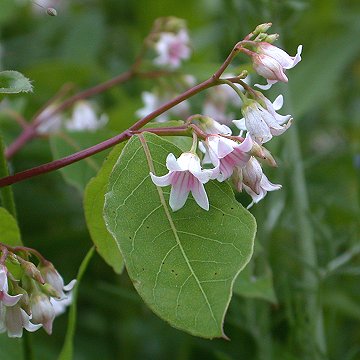

Apocynum androsaemifolium - (image 1 of 3)
Taxonomy
Family: Apocynaceae
Habitat
Upland woods. Fields and roadsides. Fire adapted.
Associates
Often found with Pteridium aquilinum.
Distribution
Newfoundland west to British Columbia, south to GA, TX, and AZ.
Morphology
Colonial perennial with milky sap, to 1 m. Leaves opposite, spreading or drooping, petiolate, sharp-pointed. Flowers in terminal cymes that often surpass the foliage; corollas pink or pink-striped, twice as long or longer than the calyx lobes. Fruit a pair of many-seeded follicles; coma of seed less than 2 cm long.
Notes
Flowers late May to early September
Wetland Indicator: Upland
Apparent hybrids between this species and A. cannabinum are called Apocynum x medium Greene. I find this species to be a bit more showy than A. cannabinum, probably because the flowers are a little larger and surpass the foliage. Plants in this genus are highly toxic if ingested, containing a cardiac glycoside (apocynamarin) which can lead to cardiac arrest, but the plants are so bitter ingestion is unlikely.
References
Foster, S. and R.A. Caras. 1994. A Field Guide to Venomous Animals and Poisonous Plants: North America North of Mexico.
Houghton Mifflin Company. New York, NY. 244 pp.
Gleason, Henry A.
and A. Cronquist. 1991. Manual of Vascular Plants of Northeastern United States
and Adjacent Canada. Second Ed.
The New York Botanical Garden. Bronx, NY
Swink, F. and G.
Wilhelm. 1994. Plants of the Chicago Region.
Indiana Academy of Science. The Morton Arboretum. Lisle, Illinois.
|
© Michael Hough 2004 |